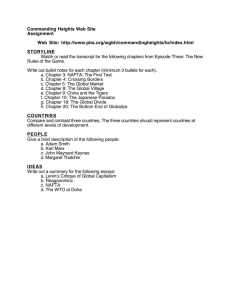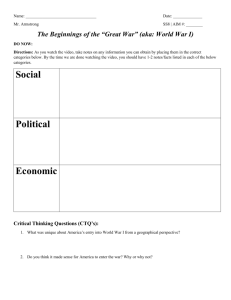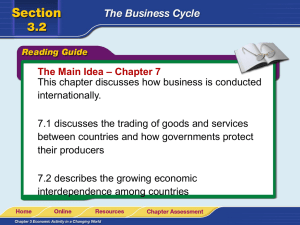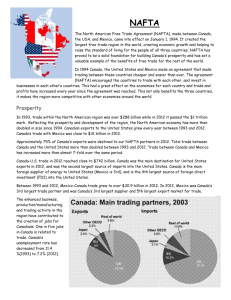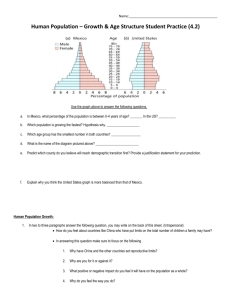M Scoring Free Trade: A Critique of the Critics S
advertisement
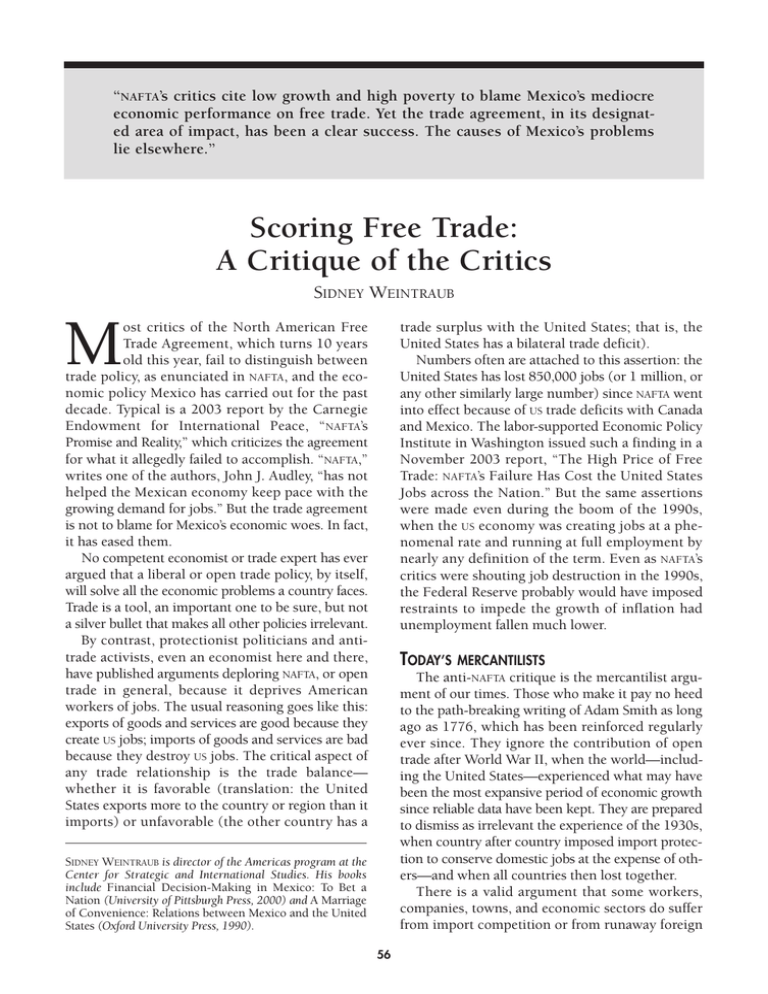
“NAFTA’s critics cite low growth and high poverty to blame Mexico’s mediocre economic performance on free trade. Yet the trade agreement, in its designated area of impact, has been a clear success. The causes of Mexico’s problems lie elsewhere.” Scoring Free Trade: A Critique of the Critics SIDNEY WEINTRAUB M trade surplus with the United States; that is, the United States has a bilateral trade deficit). Numbers often are attached to this assertion: the United States has lost 850,000 jobs (or 1 million, or any other similarly large number) since NAFTA went into effect because of US trade deficits with Canada and Mexico. The labor-supported Economic Policy Institute in Washington issued such a finding in a November 2003 report, “The High Price of Free Trade: NAFTA’s Failure Has Cost the United States Jobs across the Nation.” But the same assertions were made even during the boom of the 1990s, when the US economy was creating jobs at a phenomenal rate and running at full employment by nearly any definition of the term. Even as NAFTA’s critics were shouting job destruction in the 1990s, the Federal Reserve probably would have imposed restraints to impede the growth of inflation had unemployment fallen much lower. ost critics of the North American Free Trade Agreement, which turns 10 years old this year, fail to distinguish between trade policy, as enunciated in NAFTA, and the economic policy Mexico has carried out for the past decade. Typical is a 2003 report by the Carnegie Endowment for International Peace, “NAFTA’s Promise and Reality,” which criticizes the agreement for what it allegedly failed to accomplish. “NAFTA,” writes one of the authors, John J. Audley, “has not helped the Mexican economy keep pace with the growing demand for jobs.” But the trade agreement is not to blame for Mexico’s economic woes. In fact, it has eased them. No competent economist or trade expert has ever argued that a liberal or open trade policy, by itself, will solve all the economic problems a country faces. Trade is a tool, an important one to be sure, but not a silver bullet that makes all other policies irrelevant. By contrast, protectionist politicians and antitrade activists, even an economist here and there, have published arguments deploring NAFTA, or open trade in general, because it deprives American workers of jobs. The usual reasoning goes like this: exports of goods and services are good because they create US jobs; imports of goods and services are bad because they destroy US jobs. The critical aspect of any trade relationship is the trade balance— whether it is favorable (translation: the United States exports more to the country or region than it imports) or unfavorable (the other country has a TODAY’S MERCANTILISTS The anti-NAFTA critique is the mercantilist argument of our times. Those who make it pay no heed to the path-breaking writing of Adam Smith as long ago as 1776, which has been reinforced regularly ever since. They ignore the contribution of open trade after World War II, when the world—including the United States—experienced what may have been the most expansive period of economic growth since reliable data have been kept. They are prepared to dismiss as irrelevant the experience of the 1930s, when country after country imposed import protection to conserve domestic jobs at the expense of others—and when all countries then lost together. There is a valid argument that some workers, companies, towns, and economic sectors do suffer from import competition or from runaway foreign SIDNEY WEINTRAUB is director of the Americas program at the Center for Strategic and International Studies. His books include Financial Decision-Making in Mexico: To Bet a Nation (University of Pittsburgh Press, 2000) and A Marriage of Convenience: Relations between Mexico and the United States (Oxford University Press, 1990). 56 Scoring Free Trade • 57 investment in search of lower wages abroad (or, as these companies would put it, in search of survival). But this argument should be considered in the context of what is good for the country as a whole. Economists refer to the “fallacy of composition”—a failure to recognize that what is good (or bad) in a particular instance is not necessarily good (or bad) on a larger scale. Automobile accidents kill, airplanes crash, start-up companies fail, and life-saving vaccines sometimes impart the disease— but these individual tragedies or misfortunes do not become the basis for forsaking the underlying, generally positive activities. One can understand why a congressperson from a particular district may want to conserve local jobs against import competition, but the country is more extensive than any single district. Trade, internal or external, creates both winners and losers. The solution is to compensate the losers through retraining, salary subsidies, or other transfer techniques. Whatever the cost, this would be cheaper than punishing the entire country through protectionism. Americans learned from the SmootHawley tariff legislation in the Hoover administration that the cost of protectionism, as it reverberates around the world, can be enormous. The United States has not always handled compensation effectively, which is evident from the recurrence of protectionist demands throughout its history. However, the country in the past has always come back to its senses when it experienced the costs of trying to beggar its neighbors. What does liberal trade accomplish? It obviously lowers taxes on consumers, forces enterprises to become more competitive, fosters innovation to stay ahead of the curve, and stimulates higher productivity. These accomplishments, in turn, permit workers to earn higher incomes. Empirical data demonstrate that export industries thrive more than those industries that require protection just to survive in a domestic market. The jobs that the protectionists seek to conserve are lower-paying positions, where higher productivity cannot overcome the advantage of lower foreign wages. Protectionism is a counsel, in general, to keep the poor jobs at home even if the result is the sacrifice of good jobs. There is perhaps an even more basic question as to whether we should look at exports as a jobcreating mechanism at all. The answer is no. In the United States, where exports constitute about 10 percent of GDP (and imports, 14 percent), the critical job-creating function is assigned to overall economic policy, joined at the margin by microeco- nomic measures. The US prosperity of the 1990s was the consequence of effective domestic policy; President George W. Bush justified his tax cuts on the grounds of economic stimulation, not trade considerations. In short, the mercantilist outlook now being invoked is a chimera. Trade can affect the nature of jobs and the wages that result, but it should not be the instrument for job creation; this is the task of macroeconomic policy. Politicians love to ask, How many jobs will be gained by a trade agreement? And senior government officials and other bureaucrats who deal with trade will provide an inane answer. This calculation, however, should not be confused with reality. Nor is it relevant to a realistic assessment of NAFTA. A SUCCESSFUL EXPORT STRATEGY Mexico’s economy collapsed in 1982. This it largely brought on itself by retaining, long beyond its useful time, a system of import substitution— imposing tariffs to promote the substitution of locally produced goods for imported products. Mexico decided to shift to a new paradigm, aimed at fostering export-led growth. To this end, it unilaterally lowered its import protection, joined the General Agreement on Tariffs and Trade, and then requested negotiation of a free trade agreement with the United States. The purpose of NAFTA, from Mexico’s viewpoint, was to stimulate its domestic economy by increasing exports, and to generate higher productivity and higher wages that might go with increased exports. NAFTA is a trade agreement (or, more broadly, a trade and investment agreement). It says nothing about Mexico’s economic policy other than what is inherent in promoting exports and attracting foreign investment. Carlos Salinas de Gortari, Mexico’s president at the time, was conscious of the fact that other countries, particularly in East Asia, had done much better than Mexico in terms of economic development in the post–World War II period. Asian growth was based on many factors, the details of which differed by country—a strong educational base, sound macroeconomic policy, and the promotion of exports—and Mexico was aware of this last consideration. It is also true, as World Bank researchers have made clear in recent studies, that the countries that successfully escaped underdevelopment in the postwar period and attained a reasonable level of per capita income focused much of their policy on export growth—but not uniquely on this. In its own terms—the expansion of trade and the attraction of more foreign investment—NAFTA has 58 • CURRENT HISTORY • February 2004 succeeded beyond anyone’s expectations. Mexico’s been in effect long enough when the exchange-rate exports to the United States increased at an annual crisis unfolded for it to be blamed—although critaverage rate of 14 percent from 1993 to 2002; its ics tried to do so. It is not necessary here to go into exports to the rest of the world grew by only 8 perall the causes of the collapse. Among these were cent a year over this period. Canada’s exports to the Mexico’s depletion of foreign reserves to protect an United States also increased by more than they did overvalued peso, the consequent inability to roll to the rest of the world (7 percent as compared with over or pay dollar-indexed foreign debt as it was 1 percent over this period). Meanwhile, US annual coming due, and a succession of horrors preceding the collapse, including the assassination of a Mexexports to Mexico rose during this time by 10 perican presidential candidate and the repercussions of cent a year, compared with a 4 percent annual six alterations in the US federal funds rate. increase with the rest of the world. Put differently, intra-NAFTA trade grew by 106 percent over the The existence of NAFTA, by contrast, can be credperiod from 1993 to 2002, whereas trade by the ited with ameliorating the impact of the economic decline and helping in the country’s recovery. MexNAFTA countries with the rest of the world rose by ico under NAFTA was assured access to US markets. 42 percent. The data on foreign direct investment (FDI) in As the domestic market contracted, producers were able to expand exports to the United States in 1995 Mexico show that NAFTA succeeded in this respect by an incredible 28 percent. Mexico returned to as well. Between 1980 and 1993, Mexico received positive economic growth in 1996, which continan average of between $3 billion and $5 billion of ued during the remainder of President Ernesto FDI annually. The average inflow of FDI into Mexico, Zedillo’s six-year term. However, the Mexican econfrom all sources, after NAFTA, has been $13 billion a omy has been stagnant during the past three years, year. Not all the increase is necessarily due to the first half of President NAFTA—FDI to all destinaVicente Fox’s term. tions has increased—but it Among domestic policies is apparent that Mexico The anti-NAFTA critique is the particularly salient to the received more than it would mercantilist argument of our times. country’s recent economic have absent NAFTA. performance is the system But NAFTA is not a panacea. of taxation. Mexico’s tax Mexican GDP growth in the collections amount to about 11 percent of GDP, a years since the agreement came into existence has averaged about 3 percent a year, or less than 1.5 low figure even by Latin American standards. The percent per capita, hardly the level of growth comparable figure for the United States is 34 perneeded to allow it to emerge from underdevelopcent. In Brazil, tax collection is 37 percent of GDP. ment. Job creation has lagged, and the level of Mexico’s low level of tax collection in turn affects poverty has not diminished. But, taken on its own the central government’s ability to provide resources terms—with the goal of transforming Mexico into necessary to deal with major social concerns such a robust exporter of manufactured goods, and to as education and health care, or to help states meet augment the level of FDI to accomplish this—it is their budgetary needs. Some of the tax shortfall is made up by overtaxing Petroleos Mexicanos hard to fault the agreement. Oil accounted for about (Pemex), the national oil company, which deprives 75 percent of Mexico’s exports in the early 1980s; it of adequate funds for new oil and gas exploration today manufactured goods make up almost 90 perand exploitation. cent of the total. NAFTA’s critics cite low growth and These problems are, of course, unrelated to high poverty in order to blame Mexico’s mediocre economic performance on free trade. Yet the trade NAFTA. They antedated the agreement and have not agreement, in its designated area of impact, has been corrected since it was implemented. Mexico’s been a clear success. The causes of Mexico’s probhigh level of poverty, affecting some 40 to 50 perlems lie elsewhere. cent of the population, also antedates NAFTA. It has not been corrected since NAFTA has been in existence because of the combination of modest GDP FAILED DOMESTIC POLICIES In December 1994, the same year NAFTA went growth and budgetary insufficiency. Job creation has lagged because of the low economic growth. into effect, the Mexican peso collapsed and sent the Problems of this nature swamp the positive effects entire economy into a tailspin. Mexico’s GDP of export expansion. declined in 1995 by about 7 percent. NAFTA had not Scoring Free Trade • 59 There is a NAFTA connection to one of Mexico’s problems: regional disparities. These existed before NAFTA but were exacerbated by higher growth in the northern part of country abutting the United States and in the central valley of Mexico. NAFTA would have been a more complete agreement had it included a US commitment to provide resources for Mexico’s poorer regions—especially in the south, as the European Union does for its poorer areas. But apart from that, it is a stretch to blame NAFTA for making only part of Mexico richer and thereby augmenting regional disparities. This is clearly a failure of Mexican policy. One area of success in Mexican industrial production has been the maquiladora, the assembly plants for coproduction with the United States (and other countries), located largely at or near the US border. This system of coproduction was begun in the 1960s but has expanded sharply since NAFTA, although in slightly modified form. The expansion turned into contraction about two years ago for a variety of reasons, such as changes in the maquiladora structure and the slowdown in the US economy. In addition, because Mexico’s wages are higher than those in China or Central America, some plants have been moved to take advantage of this difference. Restored growth in production will require greater technological sophistication of the goods produced. And this, in turn, will require an upgrade of Mexico’s educational system. NAFTA may help by attracting FDI that embodies a higher technological content. President Fox, from the first day of his presidency, has highlighted the need for tax and budgetary reforms. However, his efforts to convince the opposition-dominated Congress to enact laws enabling higher tax collection have failed repeatedly. Fox has also sought, without success, to open natural gas exploration and exploitation to foreigners in order to generate more gas-powered electricity in the face of looming shortages. Mexico, despite large reserves of natural gas, imports growing quantities of it from the United States. This, too, is unrelated to NAFTA; most oil and gas issues were excluded from NAFTA at Mexican insistence. DOWN ON THE FARM has been blamed by many Mexicans, and their US sympathizers, for decimating Mexican agriculture. This agitation came to a head in 2003 when poultry producers complained about the prospective phase out of import tariffs at the end of the year, as had been agreed in NAFTA more than 10 NAFTA years earlier. Producers of other products, pork for example, made similar complaints about the agreements reached in NAFTA. Perhaps the most important criticism of NAFTA in the agricultural sector relates to corn. Corn farmers on small landholdings that produce largely for their own subsistence will be wiped out, it is argued, after tariffs on corn are scheduled to go to zero five years from now, when NAFTA becomes 15 years old. Mexico now imports corn from the United States under a quota system that allows duty-free imports within the quota and a tariff of more than 100 percent for over-quota imports. Largely because of corn shortages resulting from drought, Mexico generally has authorized over-quota imports at the in-quota zero tariff rate. There has been clamor in Mexico, including from leading politicians, to renegotiate NAFTA’s agricultural provisions—presumably not for all products, since Mexico has become an important exporter of fruits and vegetables. What seems to be happening is that some Mexican politicians are blaming NAFTA for what Mexico itself wrought in rural underdevelopment over many generations. Approximately 25 percent of Mexicans still live in rural areas, and they contribute only 6 percent of GDP. In other words, they are poor, often uneducated, with little opportunity for a better future for themselves and their children. This explains much of the outmigration A Current History Snapshot . . . “To the American mind, the most misunderstood people in the world today are the Mexican nation. The Mexicans have recently experienced a political and social revolution. This revolution has opened the way for democracy, instead of the feudalism and autocracy under which Mexico has suffered since the conquest of the country by the Spaniards in the sixteenth century. This is the one essential fact which must be known before the Mexican situation can be understood; and the meaning of this fact has apparently been grasped neither by the American people nor by their government.” “Mexico and the United States” Current History, September 1921 Frank Bohn 60 • CURRENT HISTORY • February 2004 from the Mexican countryside to larger cities in Mexico and across the border into the United States. The condition of most of these campesinos will not improve even if all corn imports cease. Mexican and US negotiators may have erred in agreeing to a 15-year phase out of import protection for key products like corn and beans; the time allowed probably should have been longer. However, the Mexicans who negotiated these provisions were convinced that the only hope for subsistence farmers and jornaleros (agricultural workers) and their families was to migrate to places where job and educational and health care opportunities were better. They miscalculated: the rate of growth thus far has not been high enough to create the necessary jobs. But the outmigration will have to happen sometime, preferably gradually and not precipitously. And NAFTA did not create the problem— though it may have entered the consciousness of Mexicans and Americans alike when NAFTA began to be used as a scapegoat for longstanding internal policy failures in the Mexican countryside. BEYOND SOUND BITES In a December 12, 2003, interview on the US National Public Radio program Marketplace, former President Carlos Salinas was asked whether he would do again what he did more than a decade ago in proposing a Mexico-US free trade agreement. After making the conventional comment about the wisdom of hindsight, he answered, “Yes.” His argument now, as it was earlier, is that Mexico needed an outlet for its production, that the domestic market was not extensive enough, and that Mexico still needs to attract FDI. But more than a sound bite is needed to analyze what has happened in Mexico during the past 10 years and what the respective contributions are from NAFTA and from economic policy generally in Mexico. The big story is economic policy and the adjunct is NAFTA—not a trivial trailer, but by no means the main feature. Economic and structural policies in Mexico have been deficient in recent years. The education system is inadequate—some 300,000 children leave school each year before age 14—and the funds to correct it are lacking, partly because of the low level of tax collection. Many entrepreneurs are leery of investing because of fears of electricity shortages and consequent high energy costs. Mexico’s savings rate is low; the country is therefore dependent on foreign capital inflows to make up the shortfall for investment purposes. The term judicial system in Mexico remains something of an oxymoron. If all of these problems are corrected, GDP could grow by as much as an additional 2 percent a year. This higher growth is vital for job creation, to provide resources to poorer regions, and to make a dent in reducing the degree of poverty. Mexico, long antedating NAFTA, is one of the most unequal countries in the world in terms of income distribution. Wages of unskilled workers have not kept up with increases in productivity, in part because the supply of workers remains abundant, a result of inadequate job creation. Skilled workers are receiving relatively high wages, and this increases the income disparity between well-educated and largely uneducated Mexicans. Mexico’s science and technology council has stressed the need to upgrade technology in the production of goods and services rather than rely on cheap labor. The reasoning is clear: Mexico cannot compete with other countries with even cheaper labor, not only in export markets, but at home. But, again, higher technology entails an improved educational system. Many of Mexico’s economic policy problems are aggravated by deep political divisions that have frustrated compromises on President Fox’s tax and energy proposals. The solution to this political problem must be found by the Mexican electorate—and it probably will be in the near future, now that Mexico is a democracy, given the extent of public frustration over the country’s poor economic performance. Most of Mexico’s economic and social policy shortcomings have not been addressed during the 10 years NAFTA has existed. The one policy initiative that has worked is NAFTA. Yet many of the trade agreement’s critics call for its destruction. They do so without explaining how that would improve the average Mexican’s economic and social condition either in the countryside or in urban areas. ■
